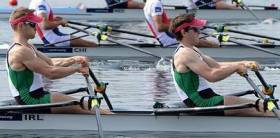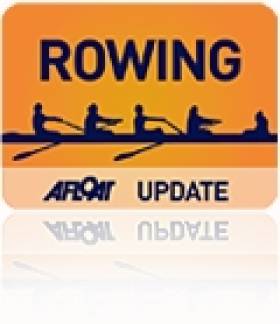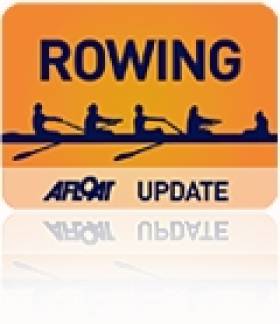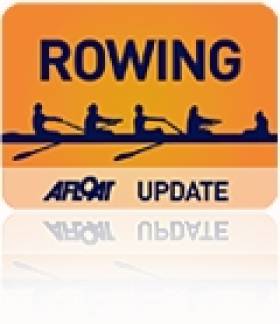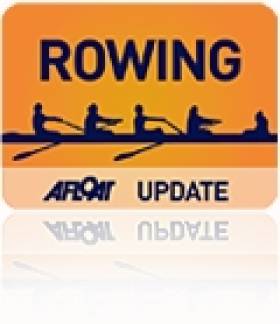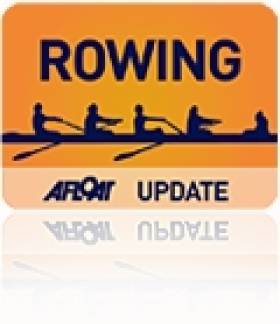Displaying items by tag: Sculling
Skibbereen Scullers Put Up Medal Challenge in Sydney
#Rowing: Paul O’Donovan and Gary O’Donovan came fifth in the Open Double Sculls at the Sydney International Rowing Regatta. The Skibbereen crew were well in contention and finished just under three seconds short of a medal place in the eight-crew contest. The Sydney/Adelaide crew of David Watts and Alexander Hill won gold. Hill had taken gold on Thursday in the men’s Open Single Sculls. Don McLachlan, the former Ireland coach, was involved in coaching both the second- and third-placed crews.
Sydney International Rowing Regatta, Day Five (Friday; Irish interest)
Men
Open Double Sculls – A Final: 1 Adelaide/Sydney (A Hill, D Watts) 6:26.08, 2 UTS/Sydney 6:28.34, 3 Sydney University-NTC 6:30.45; 5 Skibbereen (G O’Donovan, P O’Donovan) 6:33.28.
Byrne Winner of Cork Sculling Ladder
#ROWING: Ronan Byrne of Shandon Boat Club won the Cork Sculling Ladder on Thursday evening. Byrne beat Shane O’Connell of Cork Boat Club by three lengths. The 2014-2015 Ladder, sponsored by Hanley Calibration Ltd, had a delayed finish. This race should have taken place two weeks ago but was postponed due to very strong winds, which made sculling conditions dangerous. Byrne won the men’s Open, Intermediate, Junior 18 and Junior 16 sections. O’Connell was joint winner of the time trial with Daniel O’Sullivan (Lee Rowing Club) last October. Claire Synnott (Lee Rowing Club) won the women’s section. The Byrne-O’Connell race was umpired by Brian O’Flaherty, a previous winner of the sculling ladder in the 1988-89 season.
The 2015-2016 Cork Sculling Ladder will start with the Time Trial at the Marina Course on October 4th, 2015.
Result: (Thursday, April 16th): (2) Ronan Byrne (Shandon Boat Club) bt (1) Shane O’Connell (Cork Boat Club) 3 Lengths.
O'Connell and O'Sullivan Joint Winners at Cork Sculling
#ROWING: Shane O’Connell (Cork Boat Club) and Daniel O’Sullivan (Lee Rowing Club) shared the winning of the 43rd Cork Sculling Ladder Time Trial held at the Marina course in Cork today. One hundred and seventy six scullers participated in this year’s event, which is sponsored by Hanley Calibration. O’Connell and O’Sullivan posted a winning time of six minutes 54 seconds each, a five-second winning margin from Colm Hennessy (Shandon Boat Club), the 2013 – 2014 Cork Sculling Ladder overall winner. Claire Synnott (Lee Rowing Club) won the Women’s Time Trial section in 7.43. She had two seconds to spare over her clubmate Eimear Cummins. Conditions for sculling were excellent on a very calm river.
The 2014-2015 Cork Sculling Ladder continues with two-boat racing until 29th March, 2015.
Jacob Sets New Record Time at Dublin Sculling Ladder Time Trial
#ROWING: Seán Jacob set a new record time of six minutes 11.56 seconds as he won the Dublin Sculling Ladder time trial on the Liffey today. Niall O’Toole, who also took part today, had set the longstanding record of 6:14 in 1992. Dave Neale was also inside the old record, with 6:13.40. Conditions were unusually good, with a tail wind. The fastest woman home was Sheila Clavin of St Michael’s in Limerick.
The event had a record entry of 212 scullers. Former Ireland international Tim Harnedy, who has been based in the United States, also took part.
Dublin Sculling Ladder Time Trial, Islandbridge to Chapelizod:
Men: 1 S Jacob (Old Collegians) 6:11.5, 2 D Neale (UCD) 6:13, 3 A Griffin (UCD) 6:28, 4 T Hughes (UCD) 6:30, 5 D Kelly (Garda) 6:34. Women: S Clavin (St Michael’s) 7:14.
| 48th DSL Time Trial Provisional Results | |||||||||
|---|---|---|---|---|---|---|---|---|---|
| Name | Club | Overall | |||||||
| *: past winner, ~: past fastest woman | min | sec | 1/100ths | ||||||
| 1 | Sean Jacob | OC | 6 | 11 | 56 | New Record | |||
| 2 | David Neale | UCD | 6 | 13 | 40 | Beat previous record | |||
| 3 | Andrew Griffin | UCD | 6 | 28 | 79 | ||||
| 4 | Turlough Hughes | UCD | 6 | 30 | 46 | ||||
| 5 | Damien Kelly | GDBC | 6 | 34 | 36 | ||||
| 6 | Michael Bailey | UCD | 6 | 34 | 79 | ||||
| 7 | Ian Hurley | DuBC | 6 | 35 | 48 | ||||
| 8 | Patrick Moore | UCD | 6 | 36 | 3 | ||||
| 9 | Michael Maher | Commercial | 6 | 37 | 83 | ||||
| 10 | James Graham | Commercial | 6 | 41 | 93 | ||||
| 11 | Tim Harnedy | Skibbereen | 6 | 42 | 3 | ||||
| 12 | Como Gianluca | DuBC | 6 | 43 | 4 | ||||
| 13 | Alan Mc Kenna | Commercial | 6 | 44 | 8 | ||||
| 14 | Paul Mannix | DuBC | 6 | 45 | 11 | ||||
| 15 | Alexander McElovery | DuBC | 6 | 46 | 98 | ||||
| 16 | Kevin Molloy | Athlone | 6 | 47 | 51 | ||||
| 17 | Shane Mulvaney | Neptune | 6 | 47 | 97 | Fastest Juniors Man | |||
| 18 | John Magan | DuBC | 6 | 48 | 51 | ||||
| 19 | Conor Carroll | Commercial | 6 | 49 | 31 | ||||
| 20 | Luke Acheson | DuBC | 6 | 49 | 60 | ||||
| 21 | Dillion Rooney | DuBC | 6 | 50 | 97 | ||||
| 22 | Tim Keenan | Commercial | 6 | 52 | 67 | ||||
| 23 | Brendan Smyth | LEBC | 6 | 55 | 41 | ||||
| 24 | Paul Flaherty | Commercial | 6 | 55 | 48 | ||||
| 25 | William Doyle | Neptune | 6 | 55 | 84 | ||||
| 26 | Niall O Toole | Commercial | 6 | 57 | 43 | ||||
| 27 | William Yeomans | Commercial | 6 | 57 | 70 | ||||
| 28 | Dan Keegan | DuBC | 6 | 58 | 30 | ||||
| 29 | David Bell | Neptune | 6 | 58 | 56 | ||||
| 30 | Samuel Toland | UCD | 6 | 58 | 78 | ||||
| 31 | Neil Gahan | Commercial | 6 | 58 | 80 | ||||
| 32 | mARK KELLY | DuBC | 6 | 58 | 97 | ||||
| 33 | Marcus d'Estelle Roe | Commercial | 6 | 59 | 73 | ||||
| 34 | Ewan Murray | Portora | 6 | 59 | 88 | ||||
| 35 | Sam Keogh | DuBC | 6 | 59 | 98 | ||||
| 36 | Aidan Harwood | Neptune | 7 | 0 | 3 | ||||
| 37 | David Butler | DuBC | 7 | 0 | 5 | ||||
| 38 | David Cormack | Neptune | 7 | 0 | 50 | ||||
| 39 | Liam Gleeson | Commercial | 7 | 1 | 5 | ||||
| 40 | A J Rawlinson | Neptune | 7 | 1 | 31 | ||||
| 41 | Liam Hawkes | DuBC | 7 | 2 | 23 | ||||
| 42 | Kasper Coulter | DuBC | 7 | 2 | 44 | ||||
| 43 | Killian Dunne | DuBC | 7 | 4 | 6 | ||||
| 44 | Ollie Dunne | Commercial | 7 | 4 | 30 | ||||
| 45 | Mark McShane | UCD | 7 | 5 | 7 | ||||
| 46 | Myles Mc Cormick | DuBC | 7 | 6 | 1 | ||||
| 47 | Conor Ryan | DuBC | 7 | 6 | 4 | ||||
| 48 | Michael Corcoran | DuBC | 7 | 6 | 46 | ||||
| 49 | Philip Murphy | GSBC | 7 | 6 | 62 | ||||
| 50 | Niall Beggan | Commercial | 7 | 6 | 69 | ||||
| 51 | Jamie Pounch | Commercial | 7 | 7 | 25 | ||||
| 52 | Mike Heavey | Commercial | 7 | 7 | 61 | ||||
| 53 | Tom Engligh | Neptune | 7 | 7 | 64 | ||||
| 54 | Dennis Crowley | Commercial | 7 | 7 | 82 | ||||
| 55 | Barney Rix | Portora | 7 | 8 | 40 | ||||
| 56 | Francis O Toole | Commercial | 7 | 9 | 9 | ||||
| 57 | Conor Kietry | Commercial | 7 | 9 | 64 | ||||
| 58 | James O Sullivan | Blackrock | 7 | 9 | 84 | ||||
| 59 | Samuel Armstrong | Portora | 7 | 10 | 0 | ||||
| 60 | Rob Forde | Phoenix | 7 | 10 | 20 | ||||
| 61 | Reuben Cruise | DuBC | 7 | 10 | 97 | ||||
| 62 | Jim Phelan | Commercial | 7 | 11 | 29 | ||||
| 63 | Nimai Rawlinson | Neptune | 7 | 11 | 89 | ||||
| 64 | Paul Sweetman | Commercial | 7 | 12 | 0 | ||||
| 65 | Nick De Mascio | UCD | 7 | 12 | 16 | ||||
| 66 | Conolls Edwards | Commercial | 7 | 12 | 16 | ||||
| 67 | Patrick Costello | DuBC | 7 | 14 | 52 | ||||
| 68 | Sheila Clavin | St Michaels | 7 | 14 | 55 | Fastest Woman | |||
| 69 | Daire MacEoin | GSBC | 7 | 16 | 72 | ||||
| 70 | Karl Kavanagh | DuBC | 7 | 18 | 2 | ||||
| 71 | Max Riegel | DuBC | 7 | 18 | 20 | ||||
| 72 | Eimear Lambe | Commercial | 7 | 18 | 96 | Fastest Junior Woman | |||
| 73 | Pia Dolan | Neptune | 7 | 20 | 61 | ||||
| 74 | Ruth Morris | DULBC | 7 | 20 | 61 | ||||
| 75 | Evan Gebier | Portora | 7 | 20 | 97 | ||||
| 76 | Jeremy Dover | DuBC | 7 | 20 | 99 | ||||
| 77 | Derek Holland | Portora | 7 | 23 | 37 | ||||
| 78 | Naoise Greham | Commercial | 7 | 24 | 7 | ||||
| 79 | Eunan Dolan | Neptune | 7 | 25 | 51 | ||||
| 80 | Eoin Gleeson | Blackrock | 7 | 25 | 73 | ||||
| 81 | Siobhan Forman | three Castles | 7 | 26 | 58 | ||||
| 82 | Gerry Murphy | Neptune | 7 | 26 | 97 | ||||
| 83 | Emer Desay | Neptune | 7 | 28 | 15 | ||||
| 84 | Cillian Ryan | UCD | 7 | 28 | 80 | ||||
| 85 | Gemma Foley | Commercial | 7 | 29 | 3 | ||||
| 86 | Louis Mahon | DuBC | 7 | 31 | 13 | ||||
| 87 | Chris Irvine | Portora | 7 | 32 | 2 | ||||
| 88 | Aaron Johnston | Portora | 7 | 32 | 22 | ||||
| 89 | Cormac Keogh | Commercial | 7 | 32 | 55 | ||||
| 90 | George Brassil | Blackrock | 7 | 33 | 35 | ||||
| 91 | Sally O Brien | DuLBC | 7 | 33 | 51 | ||||
| 92 | Caitlin O Connor | Portora | 7 | 33 | 79 | ||||
| 93 | Hazel O Neill | DuLBC | 7 | 34 | 12 | ||||
| 94 | Ross O Mahony | Blackrock | 7 | 36 | 79 | ||||
| 95 | Scott Addison | DuBC | 7 | 36 | 87 | ||||
| 96 | Conor O Kelly | DuBC | 7 | 37 | 69 | ||||
| 97 | Turlough Eccles | Neptune | 7 | 39 | 74 | ||||
| 98 | Caitriona Jennings | Commercial | 7 | 40 | 13 | ||||
| 99 | Olive Holden | GSBC | 7 | 40 | 76 | ||||
| 100 | Sean Bergin | DuBC | 7 | 40 | 80 | ||||
| 101 | Patrick Griffin | Commercial | 7 | 42 | 38 | ||||
| 102 | Benjamin Slevin | DuBC | 7 | 42 | 41 | ||||
| 103 | Ronan Allen | GSBC | 7 | 45 | 25 | ||||
| 104 | Doug Clinch | Blackrock | 7 | 45 | 97 | ||||
| 105 | Laura Gannon | GSBC | 7 | 46 | 13 | ||||
| 106 | Michael O Rourke | Commercial | 7 | 46 | 20 | ||||
| 107 | Gillian Crowe | DuLBC | 7 | 46 | 23 | ||||
| 108 | Hugh Mohan | Blackrock | 7 | 46 | 56 | ||||
| 109 | Amy Gill Morley | cOMMERCIAL | 7 | 48 | 57 | ||||
| 110 | Ian Brennan | DuBC | 7 | 48 | 62 | ||||
| 111 | Robert Brown | Blackrock | 7 | 49 | 47 | ||||
| 112 | Alice Beacom | Portora | 7 | 50 | 49 | ||||
| 113 | Jack Brennan | Blackrock | 7 | 50 | 58 | ||||
| 114 | Joshua Shirley | Portora | 7 | 51 | 17 | ||||
| 115 | Luke Newcombe | Neptune | 7 | 52 | 64 | ||||
| 116 | Jane Coleman | Neptune | 7 | 54 | 61 | ||||
| 117 | Kelsey connolly | Neptune | 7 | 56 | 14 | ||||
| 118 | Hailey Mulvaney | Commercial | 7 | 56 | 26 | ||||
| 119 | Peter Carey | Phoenix | 7 | 56 | 62 | ||||
| 120 | Dan Coyne | Neptune | 7 | 57 | 95 | ||||
| 121 | Emma Glover | Portora | 7 | 59 | 60 | ||||
| 122 | Callum Baker | Portora | 8 | 1 | 93 | ||||
| 123 | Charlie Lawless | Blackrock | 8 | 2 | 25 | ||||
| 124 | Jack Crowley | Blackrock | 8 | 2 | 33 | ||||
| 125 | Claire Ferrick | Neptune | 8 | 2 | 78 | ||||
| 126 | Alan Thomas | LEBC | 8 | 3 | 72 | ||||
| 127 | Conor Blackwell-Smyth | Portora | 8 | 4 | 5 | ||||
| 128 | Philip O Connor | UCD | 8 | 5 | 22 | ||||
| 129 | Jim Murane | OCDc | 8 | 6 | 18 | ||||
| 130 | Elizabeth Clarke | Portora | 8 | 7 | 18 | ||||
| 131 | Mark Dignam | Blackrock | 8 | 7 | 37 | ||||
| 132 | Jack Nayle | Blackrock | 8 | 7 | 68 | ||||
| 133 | Aoife Byrne | Neptune | 8 | 7 | 87 | ||||
| 134 | Tom Mc Namara | Blackrock | 8 | 8 | 90 | ||||
| 135 | Robert Summers | Blackrock | 8 | 8 | 99 | ||||
| 136 | Ethen Hwey | Portora | 8 | 9 | 17 | ||||
| 137 | Harry Thompson | Neptune | 8 | 9 | 92 | ||||
| 138 | Scott Rolland | Blackrock | 8 | 10 | 81 | ||||
| 139 | Eimear Higgins | Commercial | 8 | 10 | 89 | ||||
| 140 | Leo Murphy | Portora | 8 | 11 | 97 | ||||
| 141 | Orlaith Kavanagh | Neptune | 8 | 12 | 89 | ||||
| 142 | Patrick Morreau | DuBC | 8 | 16 | 42 | ||||
| 143 | Harriet Doyle | Neptune | 8 | 16 | 44 | ||||
| 144 | Rory Mccluskey | Blackrock | 8 | 17 | 38 | ||||
| 145 | Cian Griffin | T DD | 8 | 18 | 28 | ||||
| 146 | Caragh Edwards | Commercial | 8 | 19 | 11 | ||||
| 147 | Jonah Carty | Portora | 8 | 20 | 7 | ||||
| 148 | Siobhan Maxwell | Commercial | 8 | 24 | 89 | ||||
| 149 | Michael O Donal | Portora | 8 | 25 | 96 | ||||
| 150 | Mia Jane Elliot | Portora | 8 | 26 | 6 | ||||
| 151 | Jenny Harrington | Commercial | 8 | 26 | 12 | ||||
| 152 | Sophie O Hare | Portora | 8 | 27 | 9 | ||||
| 153 | James O Connor | Blackrock | 8 | 27 | 59 | ||||
| 154 | Louis Manahan | Blackrock | 8 | 28 | 94 | ||||
| 155 | Sophie O Donal | Portora | 8 | 30 | 3 | ||||
| 156 | Sadhbh O Donovan | Neptune | 8 | 34 | 15 | ||||
| 157 | Alanna O Rourke | Commercial | 8 | 39 | 28 | ||||
| 158 | Ava Clarke | Neptune | 8 | 39 | 82 | ||||
| 159 | Grainne McNamara | Commercial | 8 | 41 | 29 | ||||
| 160 | Jack Butler | Neptune | 8 | 41 | 60 | ||||
| 161 | Oisin Mackin | Portora | 8 | 41 | 78 | ||||
| 162 | Patrick Haugh | Blackrock | 8 | 42 | 24 | ||||
| 163 | Harry Doherty | Blackrock | 8 | 45 | 4 | ||||
| 164 | Elaine Goode | Commercial | 8 | 47 | 56 | ||||
| 165 | Olly O Toole | Commercial | 8 | 47 | 76 | ||||
| 166 | Zoe Donaldson | Portora | 8 | 51 | 65 | ||||
| 167 | Orla McConville | Portora | 8 | 51 | 80 | ||||
| 168 | Judith Umesi | Commercial | 8 | 53 | 7 | ||||
| 169 | Elisah Tomoney | Portora | 8 | 54 | 47 | ||||
| 170 | David McGuane | Neptune | 8 | 59 | 9 | ||||
| 171 | Joanna Crawford | Portora | 8 | 59 | 11 | ||||
| 172 | Kathleen Curran | Commercial | 8 | 59 | 93 | ||||
| 173 | Sarah Meehan | Neptune | 9 | 3 | 25 | ||||
| 174 | Marcus Bradshaw | DuBC | 9 | 4 | 49 | ||||
| 175 | David McGinley | Phoenix | 9 | 5 | 38 | ||||
| 176 | Tara Gallagher | Portora | 9 | 6 | 13 | ||||
| 177 | Jane Willis | Portora | 9 | 10 | 48 | ||||
| 178 | Jack Millor | Blackrock | 9 | 11 | 62 | ||||
| 179 | Annie Rove | Neptune | 9 | 12 | 44 | ||||
| 180 | Riccardo Hei | Blackrock | 9 | 14 | 27 | ||||
| 181 | Carrie Mc Shea | Portora | 9 | 15 | 82 | ||||
| 182 | Michael Woodhouse | Portora | 9 | 18 | 29 | ||||
| 183 | Jonny Wilson | Portora | 9 | 20 | 85 | ||||
| 184 | Nathan Rodgers | Portora | 9 | 20 | 94 | ||||
| 185 | Matthew Maquire | Commercial | 9 | 22 | 33 | ||||
| 186 | Aoife Stables | Neptune | 9 | 26 | 40 | ||||
| 187 | John Moran | 9 | 28 | 27 | |||||
| 188 | Aisling Keogh | Commercial | 9 | 29 | 48 | ||||
| 189 | Rachel McCaffrey | Portora | 9 | 32 | 77 | ||||
| 190 | Alex Holten | Commercial | 9 | 34 | 33 | ||||
| 191 | Caoimhe McCaffrey | Portora | 9 | 39 | 74 | ||||
| 192 | Aine Mc Greesh | Portora | 9 | 54 | 98 | ||||
| 193 | Emily Keane | Portora | 10 | 13 | 43 | ||||
| 194 | Peter Gillespie | Commercial | 10 | 16 | 42 | ||||
| 195 | Mirian Kelly | Portora | 10 | 23 | 99 | ||||
| 196 | Hannah Sharkey | Portora | 10 | 27 | 49 | ||||
| 197 | Callum McClement | Portora | 10 | 29 | 26 | ||||
| 198 | James O Neill | Commercial | 10 | 31 | 24 | ||||
| 199 | Lydia Khew | Portora | 10 | 35 | 89 | ||||
| 200 | Katie Cassidy | Portora | 10 | 39 | 36 | ||||
| 201 | Steven Ryan | Blackrock | 10 | 55 | 81 | ||||
| 202 | Liam Rafferty | Portora | 10 | 57 | 39 | ||||
| 203 | Sophie Sherlock | Portora | 11 | 11 | 84 | ||||
| 204 | Barney Doherty | DuBC | 11 | 24 | 95 | ||||
| 205 | Charlette Boyle | Portora | 11 | 26 | 7 | ||||
| 206 | Arron O Shaughnessy | Commercial | 11 | 26 | 12 | ||||
| 207 | Helen Elliot | Portora | 11 | 28 | 76 | ||||
| 208 | Sinead Kinsella | Commercial | 11 | 41 | 69 | ||||
| 209 | Derarbhla Dillion | Portora | 12 | 52 | 53 | ||||
| 210 | Brian Cronin | DuBC | 13 | 58 | 57 | ||||
| 211 | Ellie Mix | Portora | 37 | 32 | 81 | ||||
| 212 | Anna McCool | Portora | 46 | 29 | 74 |
Dowling Brings Sculling Crown Back to Dublin
The women’s title went to the Cork Sculling Ladder, as Karen Corcoran-O’Hare was the only woman competitor.
Annual Sculling Challenge, Marina, Cork
Men
1 Dublin Sculling Ladder (C Dowling, Commercial), 2 Cork Sculling Ladder (J Griffin, Presentation College), 3 Belfast Sculling League (G Reid, Lagan Scullers’), 3l, 3l.
Women
Cork SL (K Corcoran-O’Hare, Shandon) row over.
Cork Crews Rise to the Top at Cork Head
Cork crews saw off rivals from far and near at the Cork rowing Head of the River at the Marina on Saturday. UCC’s men’s senior eight were the fastest men’s crew – by 1.3 seconds from De Maas of Rotterdam, a masters eight. The fastest women’s crew was Cork Boat Club’s junior 18 eight, adjudged just .8 of a second quicker than UCD’s women’s senior eight. The fastest men’s single sculler was John Keohane of Lee Valley and Karen Corcoran-O’Hare of Shandon was the fastest women’s single sculler.
Cork Head of the River, The Marina, Cork, Saturday
Overall: 1 UCC men’s senior eight 12 minutes 6.7 seconds, 2 De Maas, Rotterdam men’s masters eight 12:08.0, 3 UCC men’s novice eight 12:25.9, 4 UCD men’s novice eight 12:42.4, 5 Presentation College men’s junior eight 12:44.3, 6 Muckross intermediate eight 12:49.9.
Men, Eight – Senior: UCC 12:06.7. Intermediate: Muckross 12:49.9. Novice: UCC 12:25.9. Junior: Presentation 12:44.3. Junior 16: Cork 13:21.2. Masters: De Maas 12:08.0.
Fours – Senior: Cork/Garda 12:53.6. Intermediate: UCC 13:40.6. Novice: Cappoquin 13:43.9. Junior 18, coxed: Presentation 13:04.0
Pair – Junior 18: Presentation 14:58.7. Masters: De Maas 13:09.9. Coastal – Novice: Ahakista 17:28.7.
Sculling, Quadruple – Senior: Shannon 13:50.8. Novice: Shannon 15:07.4. Junior 18: Cork 13:05.3. Junior 16: Cork 13:15.2.
Double – Intermediate: Cork IT 13:41.6. Junior 18: Clonmel 13:53.9. Junior 16: St Michael’s 15:04.4. Coastal – Novice: Kilmacsimon 16:17.2.
Single – Senior: Lee Valley (J Keohane) 14:16.4. Intermediate: Lee (O’Connell) 14:53.4. Novice: Lee (O’Connell) 14:37.9. Junior 18: Workmen’s (Burns) 14:33.0. Junior 16: Shandon (Casey) 15:08.9. Masters: Skibbereen (Barry) 15:40.07. Coastal – Novice: Kilmacsimon 17:33.6
Women – Overall: 1 Cork junior eight 13:40.0, 2 UCD senior eight 13:40.8, 3 St Michael’s junior eight 13:54.1.
Eight – Senior: UCD 13:40.8. Novice: UCC 14:25.4. Junior 18: 1 Cork 13:40.0. Junior 16: Clonmel 16:21.0.
Four – Senior: Muckross 14:15.9. Intermediate: UCC 17:00.9. Novice: UCC 16:29.8. Masters: Skibbereen 22:34.9.
Pair – Junior 18: St Michael’s 15:00.2.
Sculling, Quadruple - Novice: Shannon 15:51.4. Junior 16: St Michael’s 15:16.5.
Double – Intermediate: UCC 16:15.1. Junior 18: Cork 14:43.9. Junior 16: Lee 15:42.3. Masters: Cork 15:38.3.
Single – Senior: Intermediate: Shandon (K Corcoran-O’Hare) 15:39.7. Junior 18: Lee (Kearney) 16:52.1. Junior 16: Lee (Hamel) 16:13.6. Masters: Cork (Crowley) 17:49.2.
Coastal: 1 Kilmacsimon men’s novice double scull 16:17.2, 2 Ahakista men’s novice quadruple coxed scull 17:28.7.
Click this link for Irish Rowing detailsClick this link for the Latest Rowing News


























